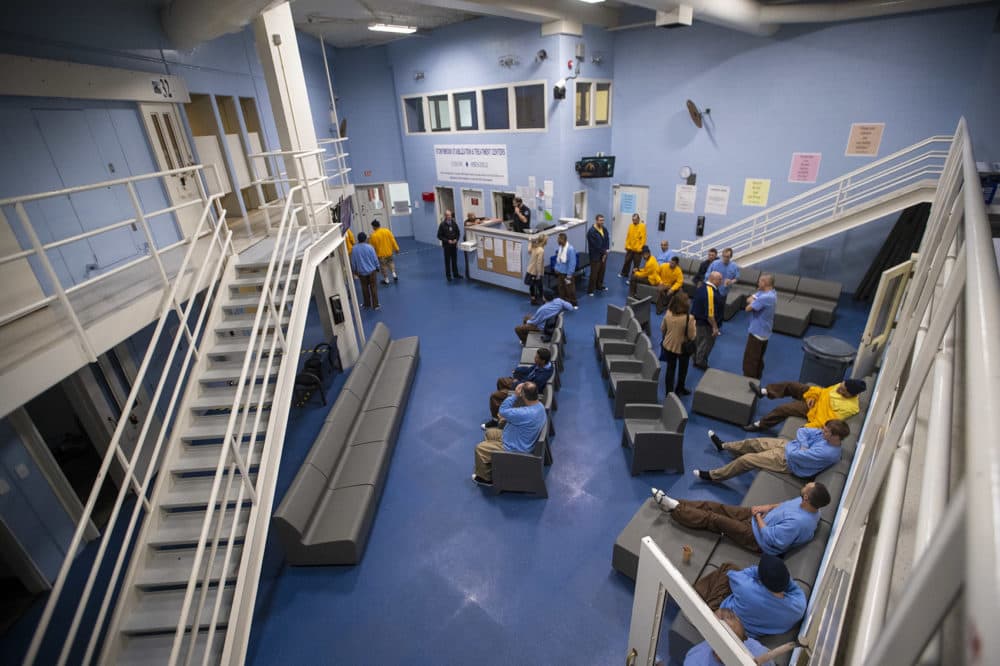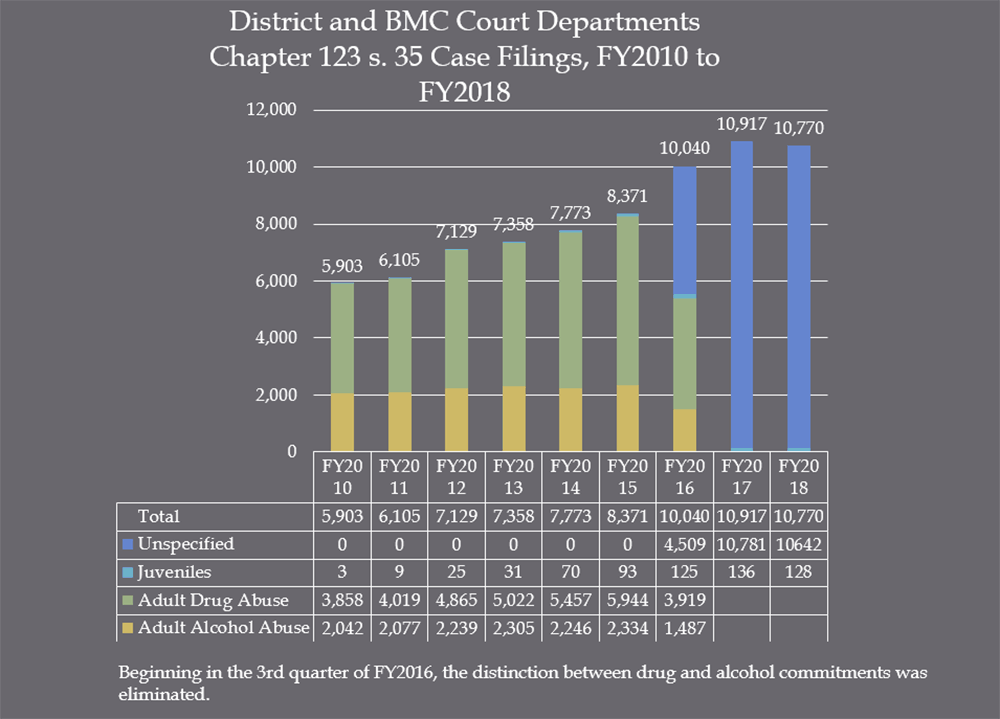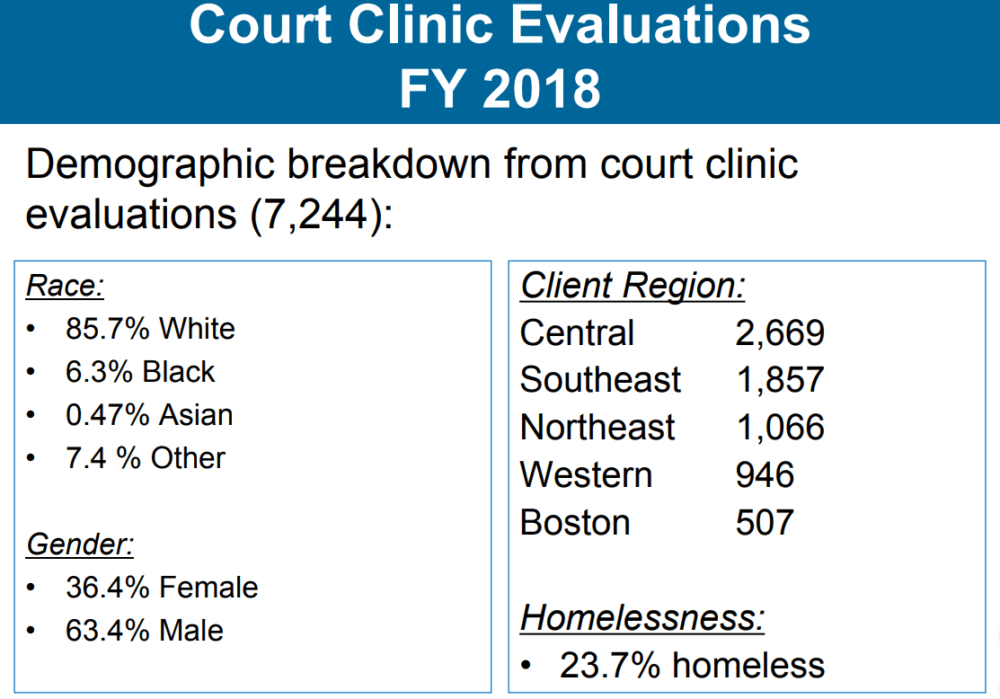Advertisement
What To Know About Section 35 Civil Commitments In Mass.

Update: The Section 35 Commission released its final recommendations this week. Read them here.
Massachusetts' Section 35 Commission was created in August 2018 as part of opioid legislation from Gov. Charlie Baker. The commission was tasked with reviewing the "efficacy" of Section 35, a state law that allows people to be involuntarily committed to addiction treatment.
Along with a look at its efficacy, the commission reviewed several other aspects of the commitment process, including the state's capacity for treatment and the legal implications of involuntarily committing someone to treatment.
The 29-member commission, which held its final hearing Thursday, heard from representatives of the courts, law enforcement, lawyers, policymakers, doctors, academics, treatment providers and people who were coerced into treatment.
Here's a look at the issue:
How many people are civilly committed to addiction treatment in Massachusetts?

There were nearly 11,000 Section 35 petitions in the 2018 fiscal year.
- Number of petitions: 10,770
- Number of evaluations conducted: 7,244
- Number of commitments: 5,716
How does Section 35 work?
A family member, police officer or health care provider asks a court to involuntarily commit someone to addiction treatment. A warrant may be issued for the individual, and police may bring the person to court for a hearing. Prior to the hearing, a judge must order an exam by a qualified clinician to assess whether the respondent has a substance use disorder and whether the person presents a likelihood of serious harm as a result of their addiction.
If serious risk or harm is established, the judge can send that person to addiction treatment for up to 90 days.
Is it legal to hold someone involuntarily who has not committed a crime?
The individual believed to have a substance use disorder has a right to counsel and may present evidence at the commitment hearing.
The Section 35 Commission did discuss whether to continue to handcuff and shackle people who have not committed crimes. After some members of the judiciary said that such restraints are often necessary, the commissioners agreed to make a draft recommendation that courts use restraints in a humane manner.
Where do people go if they're involuntarily committed to addiction treatment?
There are various facilities for those "sectioned." And oversight of them varies; some are overseen by the Department of Public Health (DPH), some by the Department of Mental Health (DMH) and some by the Department of Correction (DOC).
Massachusetts is believed to be the only state that uses correctional facilities for involuntary commitments when no crime is involved.
The state no longer sends women to prison for treatment, and is facing a lawsuit over its use of jails and prisons for civilly committed men. A bill has been filed that would prohibit the state from sending civilly committed men to criminal justice facilities.
Here are the Massachusetts facilities that treat people who have been involuntarily committed:
Women:
1) Women's Addiction Treatment Center in Brockton — 102 beds operated by High Point Treatment Center, overseen by DPH
2) Lemuel Shattuck Hospital in Boston's Jamaica Plain — 32 beds operated by High Point Treatment Center, overseen by DPH
3) Taunton State Hospital Women’s Recovery from Addictions Program (WRAP) — 45 locked beds, overseen by DMH
4) MCI-Framingham, First Step Program. The law does not authorize women to be sent to the Framingham prison unless the woman is concurrently held on bail. A woman with concurrent bail or a criminal hold may be ordered to MCI-Framingham. If bail is posted, she'd then be transferred to a DPH/DMH facility.
Men:
1) Men's Addiction Treatment Center in Brockton — 108 beds operated by High Point Treatment Center, overseen by DPH
2) Stonybrook Stabilization and Treatment Center in the Hampden County Jail in Ludlow — 85 beds. There is also a stepdown facility in Springfield, also called the Stonybrook Stabilization and Treatment Center. Both are overseen by the Hampden sheriff, who opened these facilities for Section 35 commitments in 2018.
3) Massachusetts Alcohol and Substance Abuse Center at MCI Plymouth — 251 beds, overseen by DOC
What do we know about the people being civilly committed to treatment?
Here's a breakdown of Section 35 evaluations, per DPH:

Additional facts:
-- The average length of a Section 35 commitment in the 2017 fiscal year was about three weeks.
-- Almost half of those committed under Section 35 had reported a history of using mental health medication in the year before their commitment.
Does involuntary treatment work?
The research is mixed. Some evidence suggests that certain types of people might benefit from involuntary treatment, but a 2016 review of available data did not find improved outcomes of compulsory treatment, and some studies suggested potential harm.
A DPH report provided to the Section 35 Commission said that when compared with clients without a history of involuntary treatment, clients with a history of involuntary treatment were 1.4 times as likely to die of opioid-related overdoses and 1.2 times as likely to die of any reportable cause.
A Massachusetts General Hospital report looking at the number of emergency room visits three months pre-Section 35 and four months post-Section 35 found that 91% of patients saw a reduction in ED visits after involuntary commitment.
A review of the DMH-run WRAP program for women at Taunton State Hospital found about a quarter of the women were readmitted after 30 days of discharge.
The commission reviewed one study that suggested:
The average time to relapse following commitment was 72 days, although 33.8% relapsed on the same day of their release. Longer post-commitment abstinence was significantly associated with post-commitment medication treatment, higher perceived procedural justice (i.e., fairness) during the commitment hearing, positive attitude and higher motivation at the end of commitment, and improvement in attitude during commitment.
How does Massachusetts compare with other states?
The commission reviewed a paper showing that although more than three dozen states have involuntary commitment laws, there are wide discrepancies in how those laws are used.
Florida and Massachusetts committed thousands of individuals annually, while some states like Hawaii and Texas committed fewer than 100 people in a year. States like Illinois and Utah never used their civil commitment statutes.
This article was originally published on July 01, 2019.
